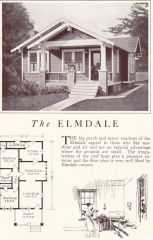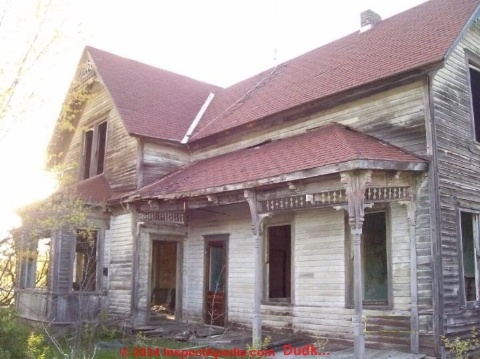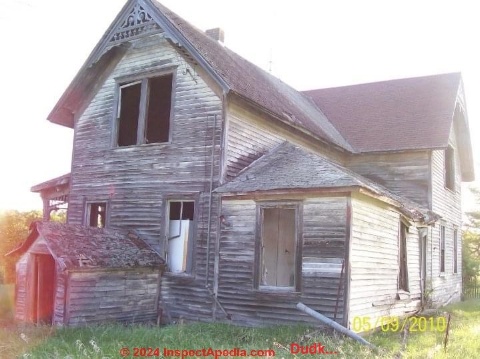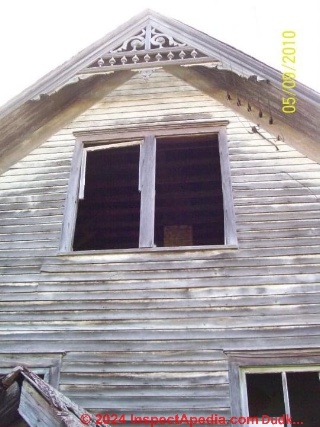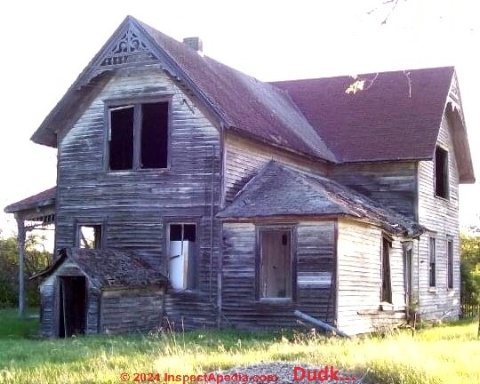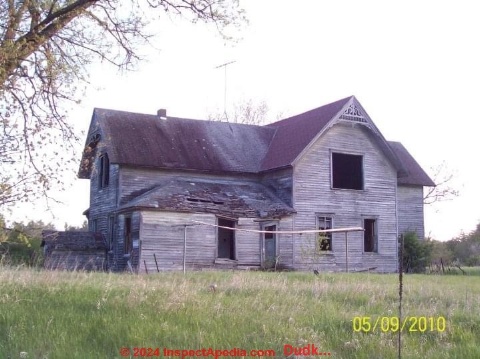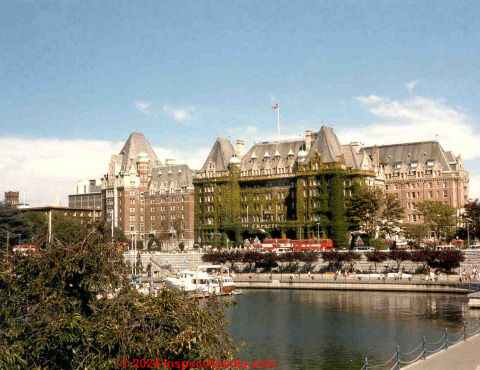 Identify & Inspect Historic, Old, & Kit Homes
Identify & Inspect Historic, Old, & Kit Homes
Home Page & Index to Articles
- POST a QUESTION or COMMENT about how to identify older & historic homes or construction details
How to identify, inspect, preserve or repair historic or old buildings: home page & index to key articles.
This list of old-house inspection, diagnosis, preservation, restoration & repair articles provides information on how to inspect, evaluate, diagnose, and repair older homes. We also provide links to home inspection standards and ethics, and home inspection methodology. Advice for home buyers includes how to choose a home inspector and how to get the most from a home inspection.
Advanced home inspection methods are presented stressing methods for increasing the detection of significant or safety defects at properties, technical expertise, and ethical conduct. Advice is provided for people interested in becoming a home inspector as well as for home buyers or owners who need to hire a home inspector.
This article series explains How to Identify & Inspect Historic Homes & Old Houses, and provides a directory to help you find a qualified home inspector who has experience and expertise in evaluating the condition of older homes.
InspectAPedia tolerates no conflicts of interest. We have no relationship with advertisers, products, or services discussed at this website.
Historic Homes, Home Improvement Costs, Home Research
- AGE of a BUILDING, HOW to DETERMINE How to Determine the Age of a Building from Visual Clues, Architectural Style, Building Materials, Construction Details, or Documentary Clues
- Amazon Books on Sears and other Kit or Catalog Houses - you can buy these great reference books on Kit Homes online
- ANTIQUE & OLD LOG CABINS
- ARCHITECTURE & BUILDING COMPONENT ID - home
for articles providing photo and drawing aids to architectural type and age of buildings and building components.
- ARCHITECTURAL STYLES- Illustrated Guide
- ARCHITECTURE, STYLE, & BUILDING AGE
- ARCHITECTURE DICTIONARY of buildings, Components
- BUILDING AGE & Architectural Style
- BUILD YOUR DREAM HOME
- CHIMNEY ARCHITECTURAL STYLES - Photo Guide
- KIT HOMES, Aladdin, Sears, Wards, Others
- MOBILE HOMES, Modulars, Panelized, & Factory-Built
- ROOFS & ARCHITECTURAL STYLES - Photo Guide
- ROOF DORMER TYPES - Photo Guide
- SIDING TYPES, INSTALLATION, DEFECTS
- WINDOW TYPES - Photo Guide
- ARCHITECTURAL STYLE & BUILDING AGE
- BRICK LINED WALLS - determining the age of older homes by bricks in wall cavities
- CHIMNEY ARCHITECTURAL STYLES - Photo Guide
- DRYWALL, FIBERBOARD, PLASTER INTERIORS - old building interior wall sheathing or cladding
- FIREPLACES & HEARTHS - home
- The Foundation Crack Bible - Foundation Cracks, Leans, Bulges, Settlement: Inspecting Foundations for Structural Defects - Detection, Diagnosis, Cause, Repair
- FRAMING MATERIALS, AGE, TYPES
- FRAMING METHODS, Age, Types
- HOPPUS MEASURER - how did they measure stuff before carpenters were good at math?
- Ice Dam Leaks on Older Homes how to predict, look for damage from, and prevent ice dam leaks in older homes
- KIT HOMES, Aladdin, Sears, Wards, Others - home
- Lead Hazards in buildings, Dust, Paint, Water: General Advice, Testing Procedures, Illnesses
- MOBILE HOMES, DOUBLEWIDES, TRAILERS - home
- MODULAR HOME CONSTRUCTION
- NAILS, AGE & HISTORY
- OLD HOUSE MYSTERIES & SOLUTIONS
- Paint Failure Diagnosis On older homes
- PLANK HOUSES
- PLASTER TYPE IDENTIFICATION
- ROOF & ARCHITECTURAL STYLES - Photo Guide
- ROOF DORMER TYPES - Photo Guide
- SAW & AXE CUTS, TOOL MARKS, AGE
- SAW BLADE SIZE CALCULATED from SAW MARKS
- SAW BLADE MARKS to SAW SIZE CALCULATION ICT
- SEARS KIT HOUSES photos and tips for identifying these interesting homes.
- SENECA HOWLAND HOUSE
- STRAW BALE CONSTRUCTION
- Structural Defects, Inspection, Diagnosis, & Repair. Rot & Insect Damage to buildings
- WINDOW TYPES, PHOTO GUIDE
Off-Site Resources for Historic or Old Homes & Buildings: Inspection, Repair, Renovation
- Association for Preservation Technology International 3085 Stevenson Drive, Suite 200 Springfield, IL 62703 Tel: 217-529-9039 Fax: 217-529-9120 Email: info@apti.org , Website: https://www.apti.org/
- Building Technology Heritage Library (Web: https://archive.org/details/buildingtechnologyheritagelibrary ) , produced by the Association for Preservation Technology, is a superb resource for old building researchers, owners, or restorers. website: https://archive.org/details/buildingtechnologyheritagelibrary
This library offers large collection of books (over 8000 in July of 2016), catalogs and other documents that are provided free to the public in a variety of electronic forms such as in PDF format or as .epub documents. The collection includes documents that are rarely found in other libraries nor in other online collections for preservationists.
Excerpt:
The Building Technology Heritage Library (BTHL) is primarily a collection of American and Canadian, pre-1964 architectural trade catalogs, house plan books and technical building guides. Trade catalogs are an important primary source to document past design and construction practices. These materials can aid in the preservation and conservation of older structures as well as other research goals. About the Building Technology Heritage Library The BTHL contains materials from various private and institutional collections. These materials are rarely available in most architectural and professional libraries.
Example: we downloaded Colt Houses (1954), [PDF, 109 MB] containing house plans produced by W.H. Colt & Son, Ltd., Bethersden Nr. Ashford, Kent. In 1954, Colt timber houses, manufactured by Colt at the company's factory in the Kentish Weald had been sold since 1930. The company described their homes as: "... they must not be considered as resembling ordinary "prefabs." When erected, each house has an individual character and there is no feeling of mass production or standardisation."
Special thanks to Mike Jackson, FAIA American architect and InspectApedia reader for suggesting this superb resource. Mr. Jackson can be contacted by email at arch419@aol.com - REFERENCES at the end of this article and all other InspectApedia articles includes citations and references
...
Reader Comments, Questions & Answers About The Article Above
Below you will find questions and answers previously posted on this page at its page bottom reader comment box.
Reader Q&A - also see RECOMMENDED ARTICLES & FAQs
Question: have a historic home inspected for soundness/preserved
I am writing to you on the off chance that you may be able to assist my husband and I on the steps of having a historic home inspected for soundness/preserved. We are in the process of purchasing my husband's family homestead.
The home has been abandoned and not taken care of for almost 30 years and I am afraid that it has been damaged beyond repair, but would like to know that for certain before we tear it down.
It has become somewhat of a local landmark and I would hate to dispose of it without at least attempting to have it inspected.
We have no real idea where to start the process of having any type of inspection done. I plan to contact the state historical society, but thought it wouldn't hurt to see if there are other avenues that may help as well.
I have included pictures of the home. Please keep in mind that these were taken over 10 years ago and there is more damage to certain parts of the home.
We were told that this was a Sears roebuck kit home or possibly two of them together.
From what I can gather, it was built in the early 1900s. Any assistance would be appreciated.
Does your website also have a list of structural engineers, by chance? - Ashley D. by private email 2024-03-15
Moderator reply:
Inspecting older buildings like the one in your photos was long a special interesst of mine, though I'm now retired from that service.
An inspection from the foundation upwards is what you'd want. If there is no real foundation or if much of the framing is rotted and damaged, there's not much there to salvage.
If that's the case, as I suspect, then only if the home had sufficient historical value would one be likely to be willing to face the cost of what is essentially a rebuild.
I would want a report by an expert that gives me a clear understanding of the condition of the building's foundation and structure before I'd consider making any repairs. I suspect this building is beyond economical repair.
Put another way, restoring the home, given its apparent condition in your photos, would perhaps cost more than construction of a new one of similar design on a bare vacant lot.
I would find a home inspector who has experience with old buildings and old building restoration; perhaps at one of these directories, depending on where this old home is located.
Those directories lists home inspectors, some of whom are structural engineers or who have other engineering degrees, but depending on what problem you're solving it would be better to make a local search for structural engineers familiar with residential construction.
HISTORIC & OLD BUILDINGS (the article above on this page) may be of some interest to you As it will be helpful to other readers, and as its publication may prompt other readers to offer a helpful suggestion.
About your question of whether or not this home was made of Sears Kit Homes, it's possible, though the number of such kits that Sears shipped arond 1900 would have been far less than in later decades. Take a look at
KIT HOMES, Aladdin, Sears, Wards, Others for tips that can help recognize or identify kit houses. And before this home is torn down, inspect it carefully for any antique hardware that remains.
If it were my property I'd want to save any interesting hardware such as hinges or door hardware, window latches, and perhaps few old boards that were in good condition.
Reader follow-up: this home is probably beyond economical repair
I appreciate your reply. I am also afraid that the damage has become too extensive for us to save this beautiful home, but I am willing to do some research to make sure of that. I don't want to destroy it without being sure of it.
I do not think we would be rebuilding if it is too far gone to save. I am willing to allow you to share our story but am hesitant to do so until we have finalized our purchase. If you add it to the site, can you please use a redacted version? Thank you for your insight.
I will look into the list of inspectors you shared with me, as well as the other links you have included. Please feel free to email me if you or anyone else is interested in any other pictures or have any questions about the property.
... I just wanted to let you know that my husband and I officially own the property I emailed you about previously! If you would like to publish our conversation and photo, please feel free to do so and include my name if you like. - 2024-04-16
Moderator reply:
How generous of you - yes I think this information will be helpful to other readers; when we have a first pass at an online report I'll ask you to take a look, and we'll be pleased to credit you as the source; but to protect your privacy we won't include contact information.
Readers interested in this home or in evaluating others like it can post questions or comments using the page bottom Comments Box.
...
Continue reading at HOME INSPECTION, GET THE MOST FROM or select a topic from the closely-related articles below, or see the complete ARTICLE INDEX.
Or see these
Recommended Articles
- AGE of a BUILDING, HOW to DETERMINE - home
- ANTIQUE & OLD LOG CABINS
- ARCHITECTURE & BUILDING COMPONENT ID
- BUILD YOUR DREAM HOME 1950 guide to building a modest home, from site selection through finish painting
- HOME CONSTRUCTION CATALOGS 1950
- KIT HOMES, Aladdin, Sears, Wards, Others
- SENECA HOWLAND HOUSE - brick stucture & wood framing repairs to a historic house
Suggested citation for this web page
HISTORIC & OLD BUILDINGS at InspectApedia.com - online encyclopedia of building & environmental inspection, testing, diagnosis, repair, & problem prevention advice.
Or see this
INDEX to RELATED ARTICLES: ARTICLE INDEX to BUILDING & HOME INSPECTION
Or use the SEARCH BOX found below to Ask a Question or Search InspectApedia
Ask a Question or Search InspectApedia
Try the search box just below, or if you prefer, post a question or comment in the Comments box below and we will respond promptly.
Search the InspectApedia website
Note: appearance of your Comment below may be delayed: if your comment contains an image, photograph, web link, or text that looks to the software as if it might be a web link, your posting will appear after it has been approved by a moderator. Apologies for the delay.
Only one image can be added per comment but you can post as many comments, and therefore images, as you like.
You will not receive a notification when a response to your question has been posted.
Please bookmark this page to make it easy for you to check back for our response.
Our Comment Box is provided by Countable Web Productions countable.ca
Citations & References
In addition to any citations in the article above, a full list is available on request.
- John Cranor [Website: /www.house-whisperer.com ] is an ASHI member and a home inspector (The House Whisperer) is located in Glen Allen, VA 23060. He is also a contributor to InspectApedia.com in several technical areas such as plumbing and appliances (dryer vents). Contact Mr. Cranor at 804-873-8534 or by Email: johncranor@verizon.net
- Mark Cramer Inspection Services Mark Cramer, Tampa Florida, Mr. Cramer is a past president of ASHI, the American Society of Home Inspectors and is a Florida home inspector and home inspection educator. Contact Mark Cramer at: 727-595-4211 mark@BestTampaInspector.com 11/06
- Roger Hankey is principal of Hankey and Brown Inspections, Winter Park, CO. Mr. Hankey is a past chairman of the ASHI Standards Committee and served in other ASHI chapter and national leadership roles. Mr. Hankey is a National Radon Proficiency Program certified measurement professional and a Level II infrared thermographer. Contact Roger Hankey at: 970-393-6604 - rogerhankey47@gmail.com . Website: www.HankeyandBrown.com Mr. Hankey is a frequent contributor to InspectAPedia.com.
- Association for Preservation Technology International 3085 Stevenson Drive, Suite 200 Springfield, IL 62703 Tel: 217-529-9039 Fax: 217-529-9120 Email: info@apti.org , Website: https://www.apti.org/
- Building Technology Heritage Library (Web: https://archive.org/details/buildingtechnologyheritagelibrary ) , produced by the Association for Preservation Technology, is a superb resource for old building researchers, owners, or restorers. website: https://archive.org/details/buildingtechnologyheritagelibrary
This library offers large collection of books (over 8000 in July of 2016), catalogs and other documents that are provided free to the public in a variety of electronic forms such as in PDF format or as .epub documents. The collection includes documents that are rarely found in other libraries nor in other online collections for preservationists.
Excerpt:
The Building Technology Heritage Library (BTHL) is primarily a collection of American and Canadian, pre-1964 architectural trade catalogs, house plan books and technical building guides.
Trade catalogs are an important primary source to document past design and construction practices. These materials can aid in the preservation and conservation of older structures as well as other research goals.
About the Building Technology Heritage Library The BTHL contains materials from various private and institutional collections. These materials are rarely available in most architectural and professional libraries.
Example: we downloaded Colt Houses (1954), [PDF, 109 MB] containing house plans produced by W.H. Colt & Son, Ltd., Bethersden Nr. Ashford, Kent. In 1954, Colt timber houses, manufactured by Colt at the company's factory in the Kentish Weald had been sold since 1930. The company described their homes as: "... they must not be considered as resembling ordinary "prefabs." When erected, each house has an individual character and there is no feeling of mass production or standardisation."
Note: On the home page for each item, there is a section as the bottom called "Reviews" It will list previous comments or ask "Be the first person to write a review." Please comment about items, as this helps the library and association better understand their users. - Building Pathology, Deterioration, Diagnostics, and Intervention, Samuel Y. Harris, P.E., AIA, Esq., ISBN 0-471-33172-4, John Wiley & Sons, 2001 [General building science-DF] ISBN-10: 0471331724 ISBN-13: 978-0471331728
- Historic Preservation Technology: A Primer, Robert A. Young, Wiley (March 21, 2008) ISBN-10: 0471788368 ISBN-13: 978-0471788362
- In addition to citations & references found in this article, see the research citations given at the end of the related articles found at our suggested
CONTINUE READING or RECOMMENDED ARTICLES.
- Carson, Dunlop & Associates Ltd., 120 Carlton Street Suite 407, Toronto ON M5A 4K2. Tel: (416) 964-9415 1-800-268-7070 Email: info@carsondunlop.com. Alan Carson is a past president of ASHI, the American Society of Home Inspectors.
Thanks to Alan Carson and Bob Dunlop, for permission for InspectAPedia to use text excerpts from The HOME REFERENCE BOOK - the Encyclopedia of Homes and to use illustrations from The ILLUSTRATED HOME .
Carson Dunlop Associates provides extensive home inspection education and report writing material. In gratitude we provide links to tsome Carson Dunlop Associates products and services.


